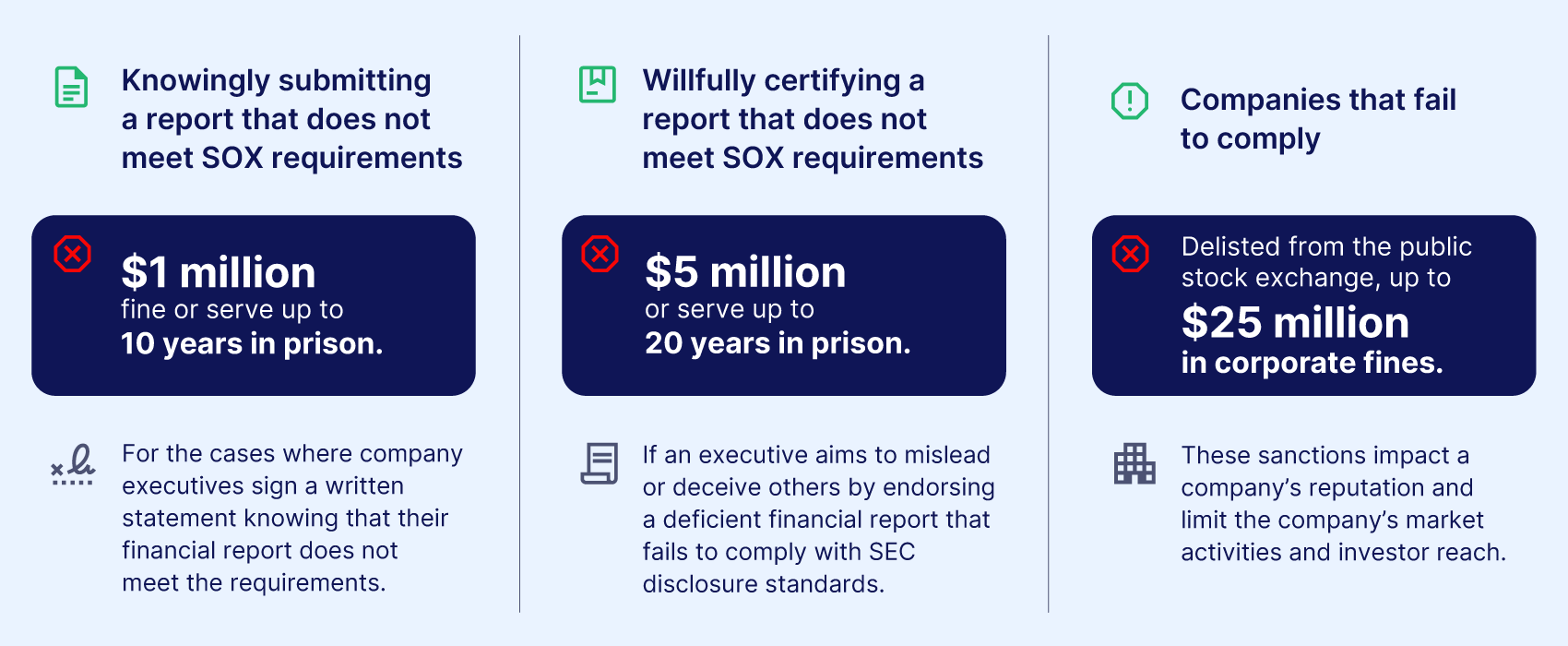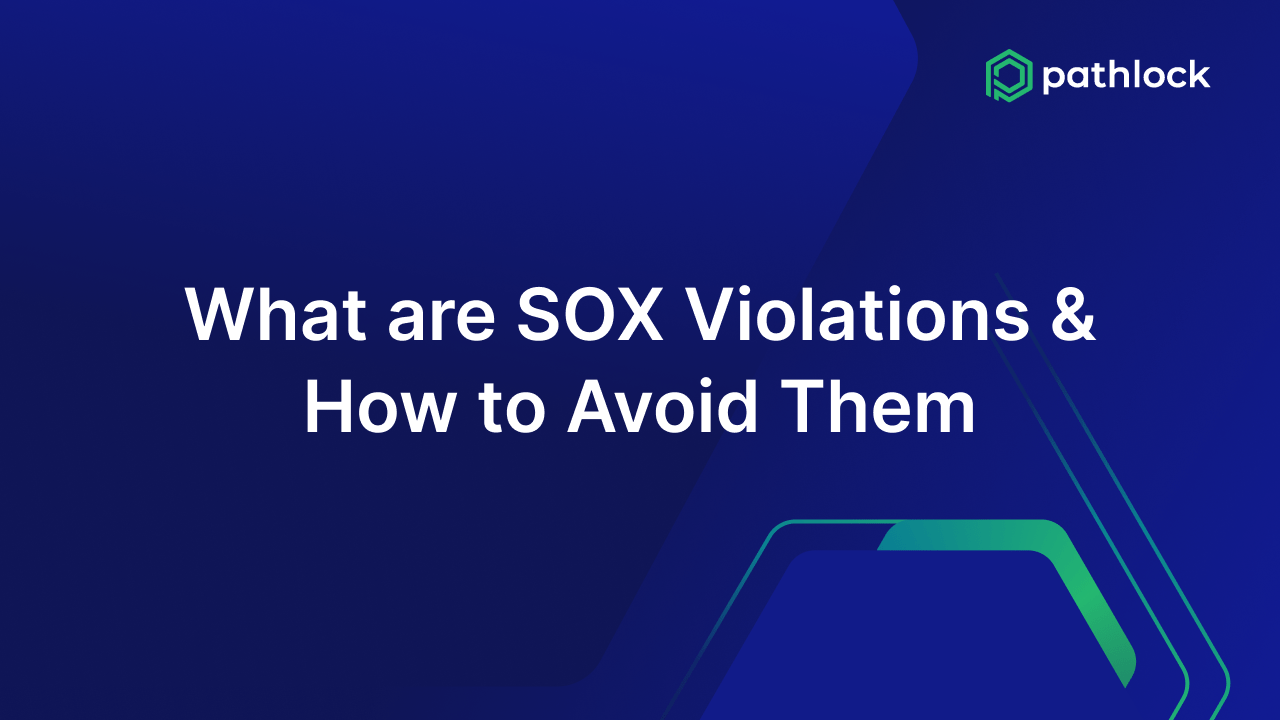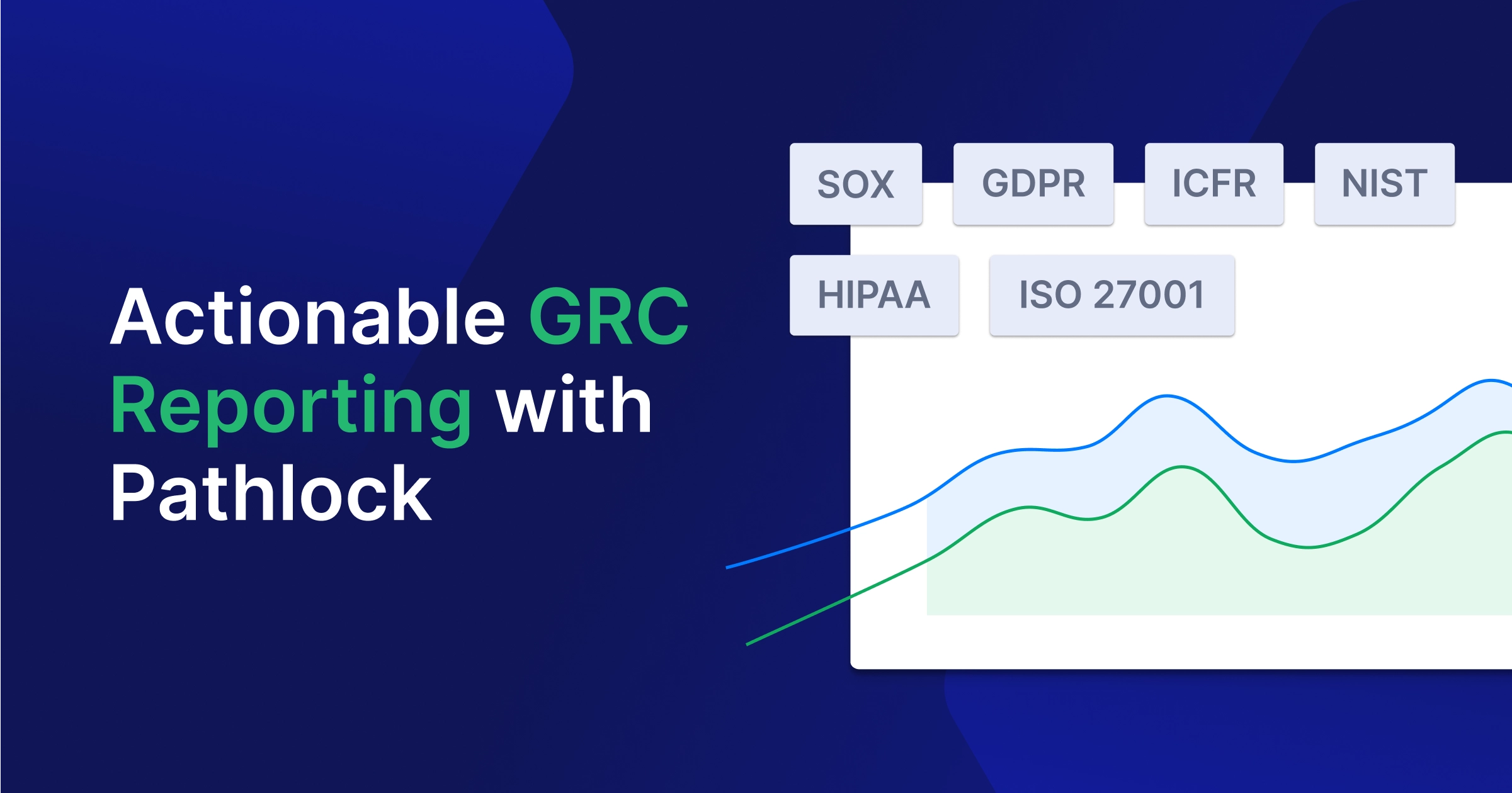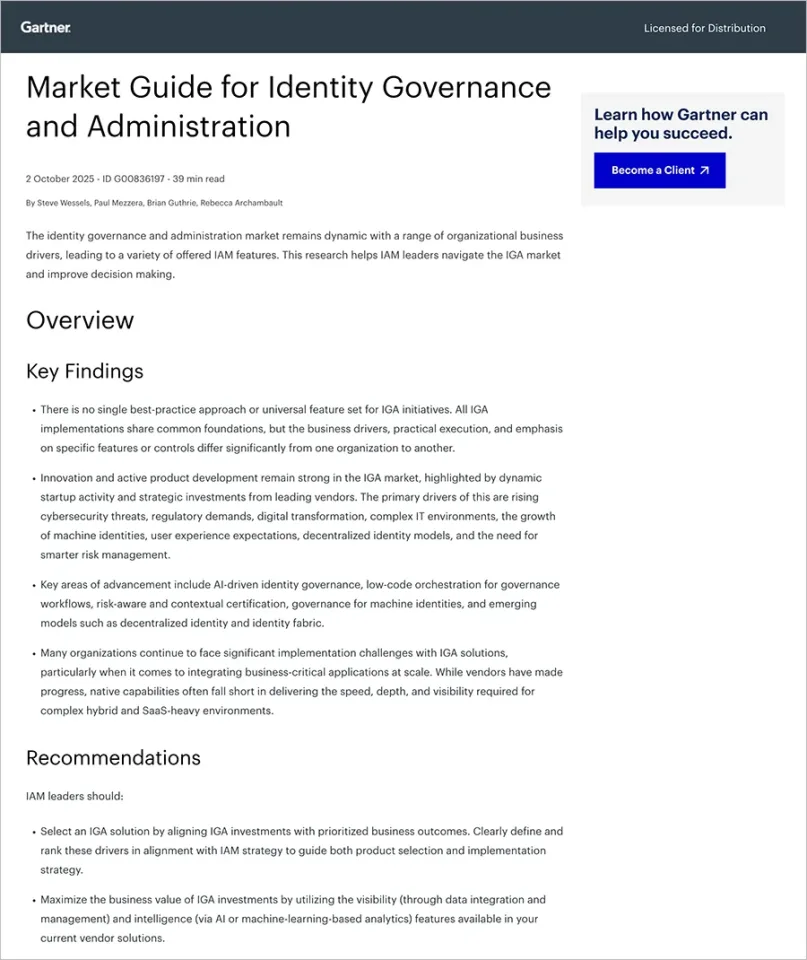In 2002, after the Enron and WorldCom financial reporting scandals, Congress created the Sarbanes-Oxley Act (SOX Act). SOX made it a crime to deceive shareholders by filing false financial reports and introduced steep penalties for mispresenting financial reports.
The SOX Act developed requirements to prevent corporate fraud by strengthening the accuracy and reliability of financial statements. It also changed the way companies designed and monitored internal controls and made auditors who evaluated them more independent from their clients. The act also allowed whistleblowers to report violations to federal law enforcement agencies.
Financial fines for non-compliance with SOX are steep: They could be up to $10,000 for individuals and $2,000,000 for organizations.
In this blog post, we will explore provisions related to the SOX penalties and costs of non-compliance and discuss how to establish a SOX-compliant environment.
Who needs to comply with SOX?
SOX provisions apply to publicly traded US companies, wholly owned subsidiaries, and international public companies that run their business in the US. Privately held companies and nonprofit organizations are not directly required to comply; however, some elements of SOX may be applied to them, such as document destruction and whistle-blower protection. Additionally, SOX regulates audit firms with the Public Company Accounting Oversight Board (PCAOB).
Why does SOX compliance matter?
Compliance with SOX regulations properly guarantees that financial statements are accurate and precise, which is critical for upholding investor trust and market stability. It also shows that the organization has implemented adequate internal controls.
While SOX’s core purpose is compliance, companies can gain additional value when looking beyond traditional compliance-related actions. Adopting improved and efficient internal controls to meet SOX requirements enables them to enhance enterprise-wide risk control and overall cybersecurity protection against security breaches and data leaks.
What are SOX Violations?
SOX violation means failure to meet the Sarbanes-Oxley Act of 2002 requirements, such as misrepresenting data in financial reports. Such misrepresentations could signify the organization hiding losses, inflating profits, and misleading stakeholders. Noncompliance with SOX can result in severe consequences, including legal actions, financial penalties, and harm to the company’s reputation.
SOX violations occur in various forms and could include:
- Breaches of SOX clauses, ranging from high-profile frauds to reporting errors.
- Submitting inaccurate financial statements, intentionally or unintentionally.
- Inadequate internal controls implemented for safeguarding financial data.
- Failure to provide written certification by the CEO or CFO.
Types of SOX Violations
Section 906(c) of the SOX Act outlines criminal penalties for intentional and unintentional violations. What happens if a company violates SOX provisions? Let’s explore how SOX defines the severity of noncompliance and what the consequences are.
Intentional vs Unintentional SOX Violations
What are intentional violations under the SOX Act?These are the cases when the organization was aware of the violations and had a chance to address the issues rather than accidentally making a mistake. They often result in criminal or civil prosecution and will likely incur significant financial penalties.
Unintentional violations under the SOX Act do not necessarily lead to financial penalties or criminal prosecution. They could include errors, oversights, incorrect data entry, and inadvertent failure to meet standards. The Securities and Exchange Commission usually mandates that companies fix the issues. However, if the ramifications for investors or issues in financial reporting are severe, even unintentional violations can result in steep penalties.
Examples of SOX Violations
Here’s the list of SOX violations examples:
- Incorrect and misleading financial statements.
- Destruction of company records.
- Inadequate internal controls over financial reporting.
- Incorrect application of accounting standards.
- Material weaknesses in external audits.
- Inappropriate collaboration between auditors and company staff.
- Circumventing or failing to maintain adequate internal controls.
- Submitting false internal control certifications.
- Failing to prepare financial statements following GAAP.
- Concealing material off-balance sheet transactions
- Inaccurately recording personal use of corporate funds as business expenses.
- Failing to disclose Section 403 transactions involving management and principal stockholders.
- Falsifying corporate accounting to underreport corporate expenses.
- Wire fraud.
Penalties for SOX Violations
The SOX Act is known for its criminal penalties and substantial fines. SOX holds top executives, CEOs, and CFOs accountable for certifying that financial reports are correct, full, and valid and satisfy SEC disclosure requirements. Executives are personally and legally responsible for this written statement that verifies financial disclosures.

Criminal penalties of the SOX Act are stated under Section 906. They include:
- Knowingly submitting a report that does not meet SOX requirements: $1 million fine or serve up to 10 years in prison. This is the penalty for cases where company executives know that their financial report doesn’t meet the requirements. However, they sign a written statement anyway.
- Willfully certifying a report that does not meet SOX requirements: $5 million or serve up to 20 years in prison. An executive faces the most brutal consequences if they aim to mislead or deceive others by endorsing a deficient financial report that fails to comply with SEC disclosure standards.
- Companies that fail to comply: Delisted from the public stock exchange, up to $25M in corporate fines. These sanctions impact a company’s reputation and limit the company’s market activities and investor reach.
Specific Sections of SOX with Criminal and Civil Liabilities
The SOX Act has two sections outlining the consequences for failing to comply with its provisions:
- TITLE VIII—CORPORATE AND CRIMINAL FRAUD ACCOUNTABILITY; Sec. 802. Criminal penalties for altering documents
- TITLE IX—WHITE-COLLAR CRIME PENALTY ENHANCEMENTS; Sec. 906. Corporate responsibility for financial reports.
Let’s review the provisions outlined in these sections.
Section 906: Corporate responsibility for financial reports
Section 906, paragraph 1350, generally talks about the consequences of corporate officers’ failures to certify financial reports. It is designed to hold the executives accountable for the accuracy and integrity of financial reports. This section explains the requirements for financial statements filed with the Securities and Exchange Commission (SEC).
Subparagraph (a), “Certification of Periodic Financial Report,” states that certification is mandatory. CEOs and CFOs personally certify that the periodic financial reports are accurate and complete.
Subparagraph (b), “Content,” talks about certification requirements. This statement must confirm that the financial report fully complies with SEC requirements and fairly represents the company’s financial condition and operational results in all material aspects.
Subparagraph (c), “Criminal Penalties,” sets penalties for those who knowingly or willfully certify false reports. Executives face maximum prison sentences of 20 years and/or fines of up to $5 million.
Section 802: Criminal penalties for document alteration
This section states that companies must ensure records and documents’ integrity and prohibit altering financial documents. The section targets cases where organizations or individuals act knowingly and with intent. The cases of minor or accidental errors are not considered under this section.
Section 802 has two paragraphs:
- Paragraph 1519 sets penalties for tampering with records. It states it’s illegal to knowingly alter, destroy, hide, or falsify records, documents, or tangible objects intending to interfere with a federal investigation or bankruptcy case. Violators face up to 20 years of imprisonment, fines, or both.
- Paragraph 1520 states that accountants who conduct organizations’ audits must keep the audit work papers and related documents for five years or more. Companies must retain all documents relating to preparing financial statements and transactions. That means that companies must have accurate data retention and activity logging enabled. SOX sets out a retention period of 5 years for all in-scope documentation. Noncompliance can result in up to 10 years in prison, fines, or both. The paragraph establishes the responsibility of the SEC to define rules for proper document retention.
The list of documents that should be protected against altering or deletion includes but is not limited to:
- Working papers
- Spreadsheets, calculations, financial models
- Notes and observations of audit procedures
- Financial statements
- Internal control assessments, risk assessments
- Emails, internal notes, and memos with internal findings or communication between auditors and clients regarding financial matters
- Audit findings.
SOX Protections for Whistleblowers
The purpose of Section 806 of the SOX Act is to establish protection for employees who are taking steps to report financial fraud. The impact of this section is to promote transparency within organizations, ethical business practices, and public safety.
In its annual Enforcement Results for 2024, the SEC summarized the results of its Whistleblower Program, which are:
- 24,000 whistleblower tips, with 14,000 from two individuals
- $255 million in whistleblower awards
- $18 million civil penalty against J.P. Morgan, the largest penalty on record for a standalone violation of the whistleblower protection rule.
Prohibited Actions Against Whistleblowers
Under SOX, companies can’t fire, demote, suspend, threaten, harass, or discriminate against employees who speak up, refuse to participate in illegal activities, report fraud, participate in investigations, or testify against a company.
Whistleblower Rights
- The right to report misconduct anonymously
- The right to report directly to the SEC for corporate fraud or other federal and state agencies, depending on the type of violation
- If employees face retaliation, they can sue the organization.
- If wrongfully terminated, they are eligible for reinstatement.
- They can get back pay with interest.
- They can get compensation for damages, including emotional distress.
- They can get legal fees to be covered by the employer.
SOX Protected Whistleblowing
SOX Act Section 806 protects whistleblowers in the cases concerning:
- Corporate fraud against shareholders
- Insider trading or manipulation of stock prices
- False statements in financial reporting
- Misrepresentation of earnings and revenue
- Failing to prepare financial statements in accordance with GAAP.
- Submitting false internal control certifications.
- Falsifying corporate accounting to underreport corporate expenses.
- Inaccurately recording personal use of corporate funds as business expenses.
- Failing to disclose Section 403 transactions involving management and principal stockholders.
Real-Word Examples of SOX Whistle-blower Cases
Murray v. UBS Securities, LLC (2024)
Trevor Murray worked at UBS, a large financial firm, providing independent reports on the firm’s securities business. He reported to his supervisor that certain UBS trading desk leaders wanted to fudge the numbers and make things look better than they really were. Shortly after making those reports, Murray was terminated. He took it to court, saying he was fired for reporting unethical practices. The jury initially agreed with him, but the Second Circuit later vacated this decision, requiring proof that UBS meant to punish Murray for speaking up.
Finally, the Supreme Court ultimately reversed the Second Circuit’s ruling, asserting that Murray didn’t need to prove UBS had a bad intent. Murray only needed to show that his whistleblowing was a factor in his firing. This case was a big win for whistleblowers, underscoring the protection SOX provides them.
E. Erhart v. Bank of Internet (BofI) Federal Bank (2023)
In this case, the court upheld a jury’s decision favoring Charles Erhart, a former internal auditor at Bofl. It awarded him $1 million in damages for retaliation and $500,000 for defamation. The jury sided with Erhart, concluding the bank retaliated against him for reporting fraud. Bofl Federal Bank tried to argue that it was justified in firing Charles Erhart for job abandonment after he took medical leave. But the court rejected this argument.
This case demonstrates the extensive legal battles and significant financial consequences companies can face under SOX for retaliation against whistleblowers.
SEC $18 million sanction against J.P. Morgan Securities (2024)
In July 2024, the SEC announced charges against J.P. Morgan Securities for violating whistleblower protections. JPMS agreed to pay a $18 million civil penalty to settle the charges. From March 2020 to July 2023, JPMS regularly asked their clients to sign confidentiality agreements that did not permit them to contact the SEC voluntarily. This practice violated Rule 21F-17 (a) under the Securities Exchange Act, which protects whistleblower communication with the SEC.
Wells Fargo Whistleblower Case (2022)
The U.S. Department of Labor’s Occupational Safety and Health Administration (OSHA) ordered Wells Fargo to pay over $22 million for retaliating against a senior manager who reported financial misconduct. The employee had been terminated after raising concerns about alleged illegal activities, including falsifying customer data and price fixing. The investigation revealed the termination was retaliatory, violating SOX’s whistleblower protections. The compensation included lost wages, benefits, and damages. This case highlights the severe penalties companies face for retaliating against employees who report financial misconduct.
How to Prevent SOX Violations
Here’s the list of best practices to prevent SOX violations:
Perform risk assessments.
Ensure your organization has controls to identify and assess potential risks related to financial data. Risk assessments need to be performed regularly, and mitigation strategies should be developed based on those assessments.
Implement SOX reporting dashboards
Consider implementing compliance software that would allow the development of visual dashboards to track key metrics and check compliance status.
Ensure robust documentation maintenance.
Ensure proper documentation is maintained and easily accessible. It’s critical to verify documentation for the executive’s review.
Determine materiality in SOX.
Evaluate whether errors or omissions in financial reports could significantly influence stakeholders’ decisions. Also, ensure those errors are fixed and disclosed in compliance with SOX.
Design and implement internal controls
Ensure you have processes and procedures enabled for regular assessment of internal controls to safeguard your financial data against errors and fraud.
Run internal control tests
Regularly test internal controls to ensure their effectiveness.
Conduct regular audits and reviews
To monitor compliance, conduct regular internal audits, and engage external auditors to confirm SOX compliance.
Whistleblower protection.
Ensure that whistleblowers are protected and their concerns are handled appropriately and in compliance with SOX requirements. Provide communication channels for raising concerns.
Implement data security and safe data management practices
SOX-compliant companies need to protect financial data against unauthorized access and data breaches. For that, consider implementing:
- Regular data backups and data retention policies.
- Change management to establish control over changes to financial systems and ensure the changes are documented.
- User access review to verify access policies running and revoke unnecessary access to sensitive systems and data.
- Run employee training. Train employees on SOX requirements and responsibilities regarding financial data protection, as well as clear ethical guidelines and a culture of compliance linked to SOX.
Real-Life SOX Violation Examples and Penalties
Over the years, numerous SOX violation examples have offered valuable lessons. This section will review some notable cases, examine the violations, understand how they occurred, and highlight key takeaways.
QSGI Inc.: Certification Failures at the Executive Level
Violation: Misrepresentation of internal controls, falsified accounts, and failure to improve compliance.
Takeaway: Companies must implement robust internal controls and employee training, improve certification, and invest in fixing issues.
What happened: Back in 2014, the SEC charged executives at IT equipment manufacturer QSGI with misrepresenting the state of internal controls. The company falsely certified its controls and disclosures to enhance its financial standing. When these actions were uncovered, the company hadn’t fixed the weaknesses of its internal controls. This happened because the company lacked adequate staff training and had flawed systems.
Monsanto: Smart Marketing but Negligent SOX Compliance
Violation: Failing to record state-funded rebates. Misleading investors.
Takeaway: Clearly define revenue streams, ensure accuracy in financial reporting, and prioritize compliance over short-term gains.
What happened: In 2016, the SEC fined Monsanto $80 million for accounting irregularities related to its Roundup pesticide sales. The company failed to record rebates funded by state programs, inflating its earnings over three years. This tactic misled investors and triggered SOX enforcement.
ArthroCare: How Violating SOX Can Lead to Prison Time
Violation: Misstating revenues. Fake distributor incentives. Misleading investors.
Takeaway: SOX compliance requires strong business ethics and the implementation of strong internal controls.
What happened: In 2018, ArthroCare’s former CFO was sentenced to 50 months in prison for a $750 million fraud. For several years, he and his team routinely misstated revenue. They used fake incentives to boost end-of-quarter sales figures. These deceptive practices falsely suggested that ArthroCare exceeded Wall Street expectations. These actions ultimately cost millions to investors.
How Pathlock Helps Prevent SOX Violations
Pathlock Cloud is a leading technology solution designed to help organizations automate compliance processes. It addresses important SOX requirements, especially in financial reporting, access management, and audit trails.
I. Implement Internal Control Over Financial Reporting (ICFR) with Pathlock
This is the core of SOX compliance. Auditors assess the effectiveness of controls designed to ensure the accuracy and reliability of your financial reporting. Key areas within ICFR include:
- Risk Assessment: How the company identifies and analyzes financial reporting risks and manages those risks. Pathlock AAG helps identify and assess access-related risks, while CCM allows for ongoing monitoring and analysis of those risks.
- Control Activities: The specific actions taken to address risks, such as approvals, authorizations, verifications, reconciliations, reviews of operating performance, and segregation of duties. AAG automates key control activities such as user provisioning, movement, and de-provisioning of users. It provides elevated access management, user access reviews, certifications, and role management, which improves efficiency and accuracy. CCM consolidates controls, continuously monitors the effectiveness of these controls, and provides risk quantification in financial terms.
- Information and Communication: How the company communicates financial reporting responsibilities and information, both internally and externally. Pathlock provides reporting information supporting audit responses for compliance requirements like the U.S. Securities and Exchange Commission cybersecurity rule of July 2023, requiring rapid disclosure of material breach information.
- Monitoring Activities: Ongoing evaluations of the effectiveness of internal controls, including periodic audits and reviews. Pathlock provides real-time monitoring of violations of business process controls and IT general controls. Monitoring changes to configurations, settings, and master data, as well as the ability to configure custom events to monitor across all transactions, is a key differentiator.
II. Implement IT General Controls (ITGCs) with Pathlock
These controls support the effective operation of the ICFR by ensuring the reliability of IT systems. Key areas within ITGCs often include:
- Access Controls: Restricting access to systems and data to authorized personnel only. This includes logical access (passwords, multi-factor authentication). Pathlock provides access restrictions based on access risk analysis and compliant provisions supported by role management.
- Change Management: Ensuring that changes to IT systems are authorized, tested, and implemented in a controlled manner to prevent unintended consequences. Pathlock monitors changes to IT configuration settings and master data, including the original value, the adjusted value, and values that have been deleted.
- IT Security: Implementing measures to protect IT systems and data from unauthorized access, use, disclosure, disruption, modification, or destruction. This includes firewalls, intrusion detection systems, and security awareness training. Pathlock provides Cybersecurity Application Controls, including vulnerability management, threat detection and response, and transport control to protect IT systems and data. Some areas of IT Security, like firewalls and security awareness training, are covered by other solutions.
III. Implement Entity-Level Controls (ELCs) with Pathlock
These controls operate across the entire organization and have a pervasive impact on the control environment. Examples include:
- Fraud Prevention Program: Implementing measures to deter, detect, and prevent fraud. Pathlock provides continuous control monitoring to monitor the separation of duties violations a user has committed, supported by risk quantification and mitigation steps to prevent fraud.
IV. Implement Disclosure Controls and Procedures with Pathlock
These controls ensure that the company meets its obligations to disclose material information to investors promptly and accurately. This includes:
- Completeness and Accuracy of Financial Reporting: Ensuring that all material information is included in financial reports and free from misstatements. Financial reporting includes reporting financial transactions outside the governance, risk, and compliance areas.
- Timeliness of Reporting: Meeting deadlines for filing financial reports with the SEC. Pathlock provides real-time reporting supporting SEC reporting related to compliance with disclosure material breaches within the SEC cybersecurity rules.
- Internal Reporting: Providing management with the information it needs to make informed decisions about financial reporting. Pathlock provides information about the separation of duties violations and monitored transactions to support accurate reporting.
V. Conduct SOX Audits with Pathlock
SOX audits may also cover areas such as:
- Remediation of Deficiencies: Developing and implementing plans to correct any control deficiencies identified during the audit. Pathlock allows you to identify control deficiencies and fix them before an audit. Accountability provides management with tools to confirm the accuracy and confidence of financial reports.
- Fraud Risk Assessment: Identifying and assessing the risk of fraud within the organization. Pathlock provides continuous control monitoring to monitor the separation of duties violations a user has committed, supported by risk quantification and mitigation steps to prevent fraud.
Conclusion
Since its implementation over twenty years ago, SOX has remained a challenge for many organizations. Managing SOX compliance demands scrutiny, forward-thinking strategies, and continuous improvement of processes and controls. Addressing inefficiencies and responding to compliance requirements should be a priority for all businesses affected. By investing in the right software, companies can reduce the amount of labor needed to adhere to reporting requirements without a correlative loss in information accuracy.
Frequently Asked Questions (FAQ)
What is a SOX violation?
SOX violation means failure to meet the Sarbanes-Oxley Act of 2002 requirements, such as misrepresenting data in financial reports. Such misrepresentations could signify the organization hiding losses, inflating profits, and misleading stakeholders. Noncompliance with SOX can result in severe consequences, including legal actions, financial penalties, and harm to the company’s reputation.
Who is subjected to fines and imprisonment for SOX violations?
Under the SOX Act, both organizations and individuals are responsible for failing to comply with SOX requirements. CEOs and CFOs who knowingly or willfully certify false financial reports can face financial penalties, imprisonment, or both. Companies that fail to comply can be delisted from the public stock exchange and receive up to $25M in corporate fines.




